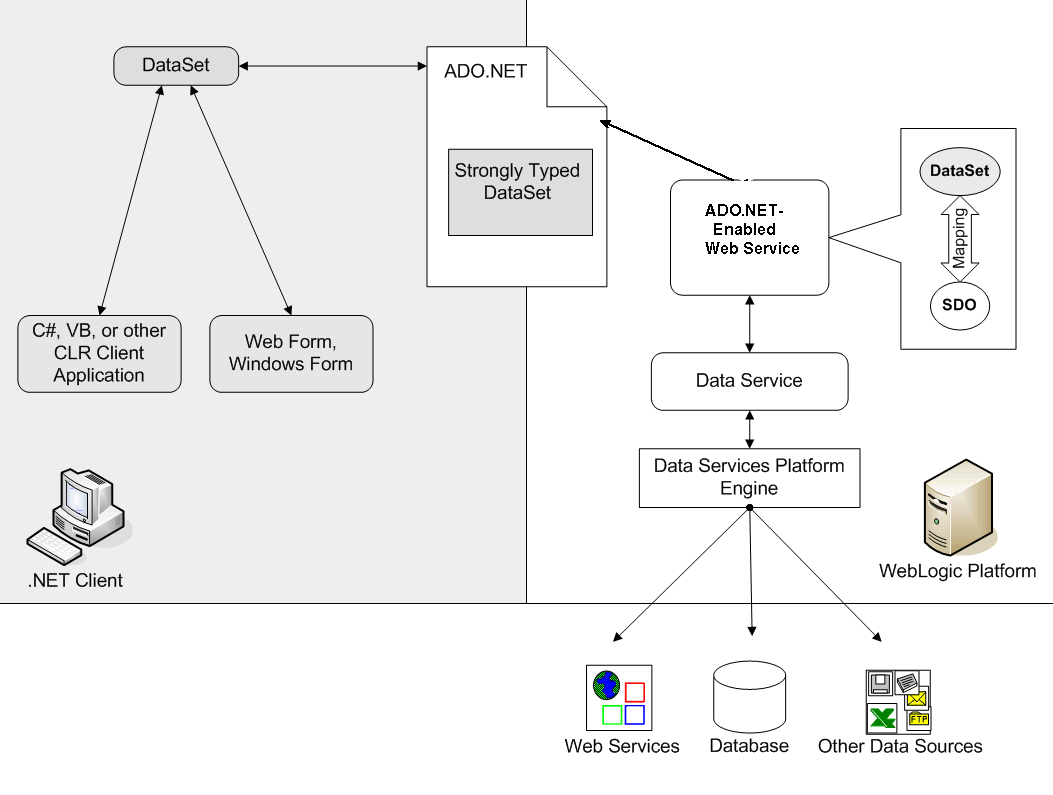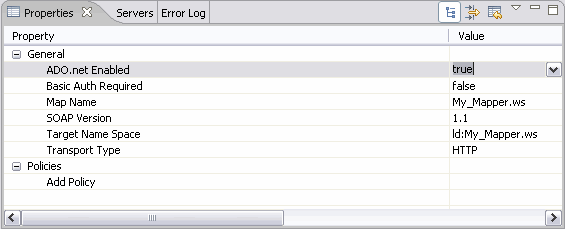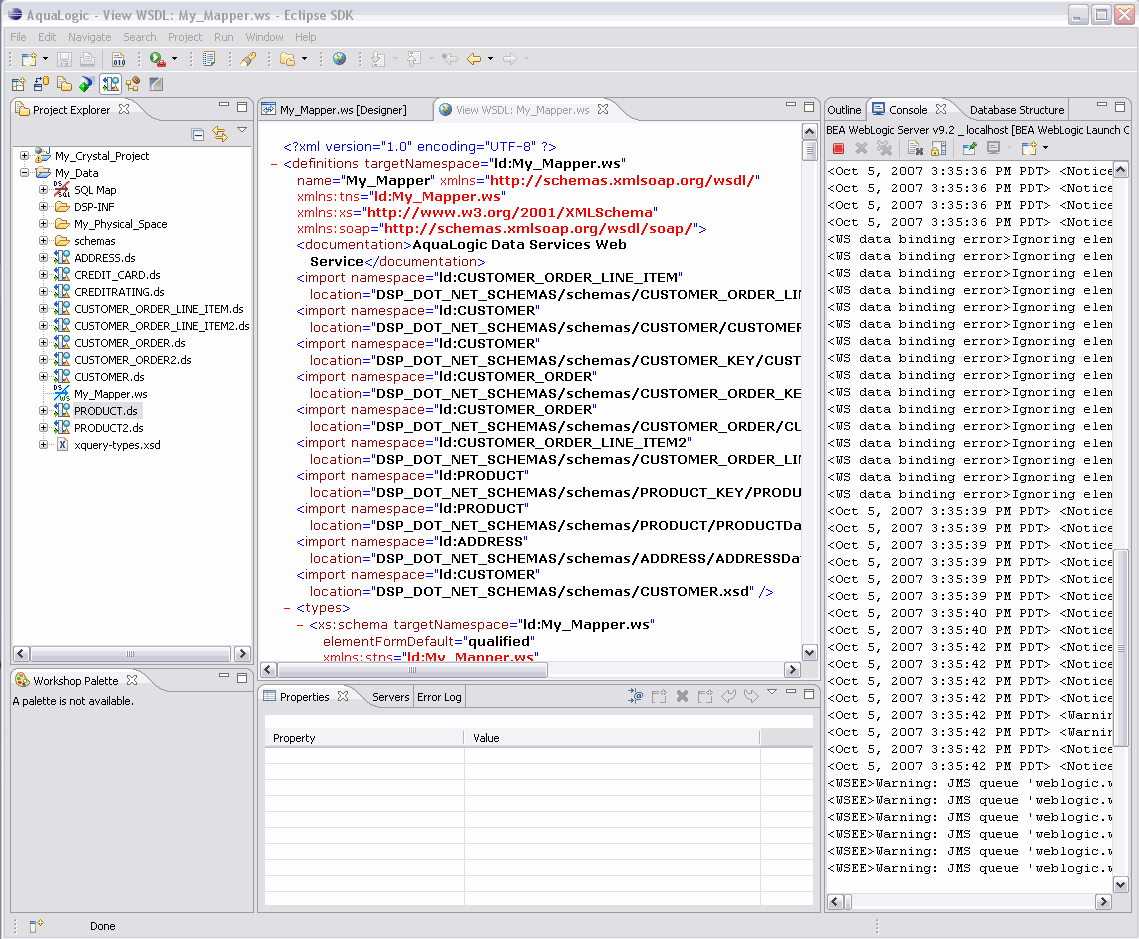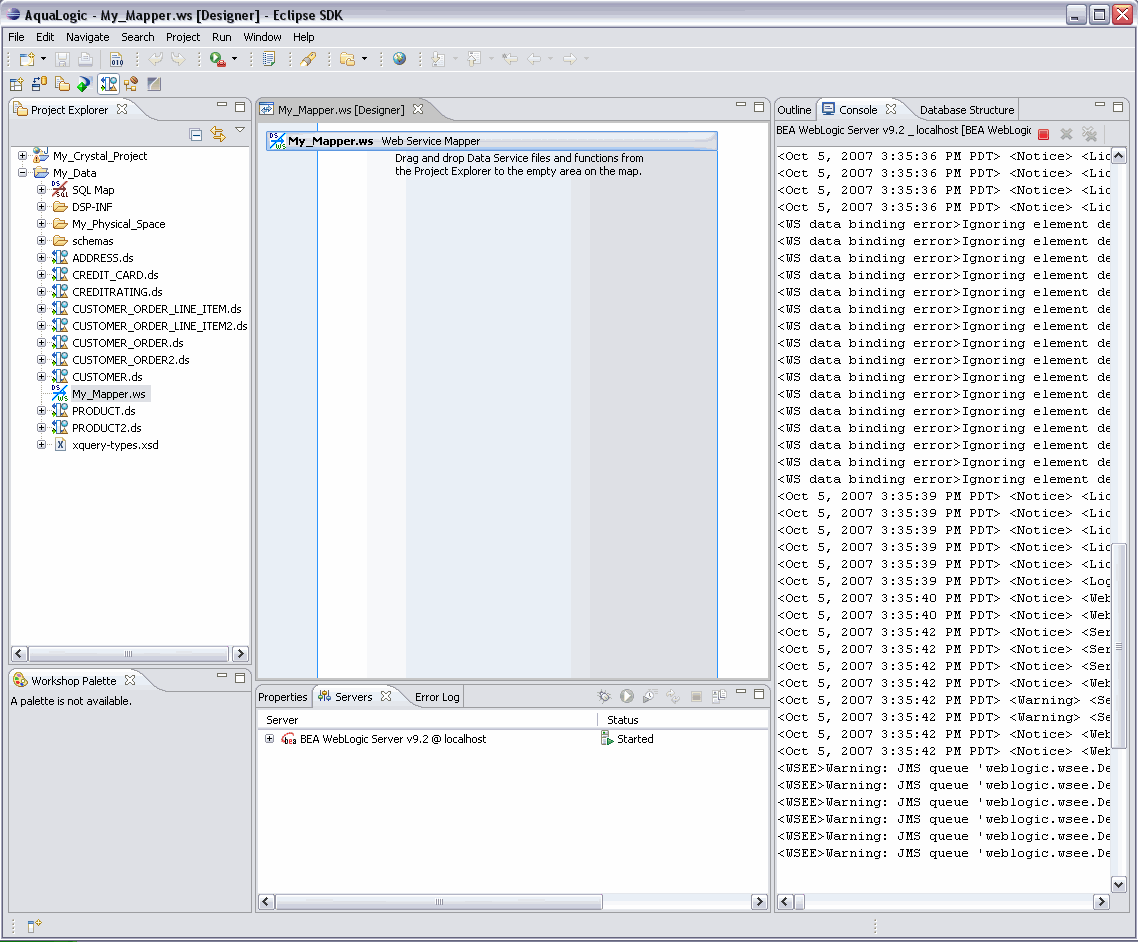6 Supporting ADO.NET Clients
This chapter describes how to enable interoperability between Oracle Data Service Integrator and ADO.NET client applications. With support for ADO.NET client applications, Microsoft Visual Basic and C# developers who are familiar with Microsoft's disconnected data model can leverage Oracle Data Service Integrator data services as if they were ADO.NET Web services.
From the Microsoft ADO.NET developers' perspective, support is transparent: you need do nothing extraordinary to invoke Oracle Data Service Integrator operations (functions and procedures)—all the work is done on the server-side.
ADO.NET-client-application developers need only incorporate the Oracle Data Service Integrator-generated web service into their programming environments, as you would when creating any Web service client application.
Information about how Oracle Data Service Integrator achieves ADO.NET integration is provided in this chapter, along with the server-side operations required to enable it. The chapter includes the following sections:
-
Section 6.1, "Overview of ADO.NET Integration in Oracle Data Service Integrator"
-
Section 6.1.4, "Enabling Oracle Data Service Integrator Support for ADO.NET Clients"
-
Section 6.2, "Adapting Oracle Data Service Integrator XML Types (Schemas) for ADO.NET Clients"
-
Section 6.3, "Creating a Data Service Based on an RPC-Style Web Service"
-
Section 6.4, "Generated Artifacts Reference"
Note:
The details of ADO.NET development are described on Microsoft's MSDN Web site (
http://msdn.microsoft.com). See this site for information about developing ADO.NET-enabled applications.
6.1 Overview of ADO.NET Integration in Oracle Data Service Integrator
Functionally similar to the service data object (SDO), ADO.NET (Active Data Object) is data-object technology for Microsoft ADO.NET client applications. ADO.NET provides a robust, hierarchical, data access component that enables client applications to work with data while disconnected from the data source. Developers creating data-centric client applications use C#, Visual Basic.NET, or other Microsoft .NET programming languages to instantiate local objects based on schema definitions.
These local objects, called DataSets, are used by the client application to add, change, or delete data before submitting it to the server. Thus, ADO.NET client applications sort, search, filter, store pending changes, and navigate through hierarchical data using DataSets, in much the same way as SDOs are used by Oracle Data Service Integrator client applications.
See Section 2.3, "Role of the Mediator API and SDO" for more information about working with SDOs in a Java client application. Developing client applications to use ADO.NET DataSets is roughly analogous to the process of working with SDOs.
Although functionally similar on the surface, as you might expect with two dissimilar platforms (Java and .NET), the ADO.NET and SDO data models are not inherently interoperable. To meet this need, Oracle Data Service Integrator provides ADO.NET-compliant DataSets so that ADO.NET client developers can leverage data services provided by the Oracle Data Service Integrator, just as they would any ADO.NET-specific data sources.
Enabling a Oracle Data Service Integrator data service to support ADO.NET involves the following steps:
6.1.1 Understanding ADO.NET
ADO.NET is a set of libraries included in the Microsoft .NET Framework that help developers communicate from ADO.NET client applications to various data stores. The Microsoft ADO.NET libraries include classes for connecting to a data source, submitting queries, and processing results.
The DataSet also includes several features that bridge the gap between traditional data access and XML development. Developers can work with XML data through traditional data access interfaces.
Note:
Although ADO.NET supports both connected (direct) and disconnected models, only the disconnected model is supported in the Oracle Data Service Integrator.
6.1.1.1 ADO.NET Client Application Development Tools
ADO.NET client applications are typically created using Microsoft Windows Forms, Web Forms, C#, or Visual Basic. Microsoft Windows Forms is a collection of classes used by client application developers to create graphical user interfaces for the Windows .NET managed environment.
Web Forms provides similar client application infrastructure for creating web-based client applications. Any of these client tools can be used by developers to create applications that leverage ADO.NET for data sources.
Figure 6-1 ADO.NET Clients Supported via Web Services

Description of "Figure 6-1 ADO.NET Clients Supported via Web Services"
Once the WSDL URL is available, your client can invoke data service operations and you can invoke functions on the data service and manipulate the DataSet objects in your code as you normally would.
Note:
The process of generating the WSDL and server-side artifacts is described in Section 6.1.5, "Generating an Oracle Data Service Integrator Web Services Mapper."
6.1.2 Understanding How Oracle Data Service Integrator Supports ADO.NET Clients
Oracle Data Service Integrator supports ADO.NET at the data object level. That is, the Oracle Data Service Integrator maps inbound ADO.NET DataSet objects to SDO DataObjects, and maps outbound SDOs to DataSets. The mapping is performed transparently on the server, and is bidirectional.
Table 6-1 ADO.NET and SDO Data Objects Compared
| ADO.NET | SDO | Microsoft .NET Description |
|---|---|---|
|
DataSet |
DataObject |
Disconnected data models. Queries return results conforming to this data model. |
|
DiffGram |
ChangeSummary |
Mechanisms for tracking changes made to data objects by a client application. |
As shown in Figure 6-2, the ADO.NET typed DataSet is submitted to and returned by Oracle Data Service Integrator. At runtime, when a Microsoft .NET client application makes a SOAP invocation to the ADO.NET-enabled Web service, the Web service intercepts the object, converts the .NET Dataset to an SDO Data Object, and passes it to Data Services.
Figure 6-2 Oracle Data Service Integrator and .NET Integration

Description of "Figure 6-2 Oracle Data Service Integrator and .NET Integration"
Mapping, transformation, and packaging processes are transparent to client application developers and data services developers. Only the items listed in Table 6-2 are exposed to data service developers.
Table 6-2 Oracle Data Service Integrator—Java and ADO.NET-Enabled Artifacts
| Name | Example | Description |
|---|---|---|
|
Data Service |
Customer.ds |
An XQuery file that instantiates operations such as read functions, navigation functions, procedures, and update functionality at runtime. |
|
Data Service Schema |
Customer.xsd |
The schema associated with the XML type of the original data service. |
|
DataSet Schema |
CustomerDataSet.xsd |
The typed DataSet schema that conforms to Microsoft requirements for ADO.NET data objects. Note that dataset xsd is not physically generated into a dataspace project. It is dynamically generated at WSDL generation time when WSDL and its imported schema files are accessed in .NET client. |
|
Web Service Map |
CustomerNET.ws |
Web Services mapper file that maps data service operations to web service operations. |
6.1.3 Supporting Java Clients
The WSDL generated by Oracle Data Service Integrator from an ADO.NET-enabled web services maps specific for use by Microsoft ADO.NET clients. Exposing data services as Web services that are usable by Java clients is generally the same, although the actual steps (and the generated artifacts) are specific to Java.
6.1.4 Enabling Oracle Data Service Integrator Support for ADO.NET Clients
The process of providing ADO.NET clients with access to data services is a server-side operation that is initially enabled in Eclipse and takes place in the context of an application and Workshop for WebLogic.
The instructions in this section assume that you have created a dataspace project and that you want to provide an ADO.NET client application with access to data services. (For information about designing and developing data services, see the Oracle Fusion Middleware Data Service Integrator Developer's Guide.
Enabling an Oracle Data Service Integrator application to support ADO.NET clients involves doing the following:
In some cases, of course, there will already be existing operations that you want to make available to an ADO.NET client.
6.1.5 Generating an Oracle Data Service Integrator Web Services Mapper
You need to generate an Oracle Data Service Integrator Web Services Mapper that maps data service functions to Web Service operations.
To generate a Web Services Mapper, do the following:
-
Right-click the project folder and select New > Web Service Mapper. Enter a filename for your .WS map file.
You can then drag and drop data service files and functions from the Project Explorer into your mapper.
-
Select Windows > Show View > Properties to display the properties for the Web Service Mapper, and the operations that you put into your Web Service mapper.
-
Click on the Mapper Bar and on the value across from ADO-NET-enabled. Then, select true for the ADO.NET-enabled option.

Description of the illustration adodotnetproperties.gif
-
Redeploy your project by right-clicking on the project name and checking Deploy Project.
6.1.6 Viewing an ADO.NET-Enabled WSDL
The system automatically generates a Web Services Description Language (WSDL) file that can be used by Web service clients to invoke operations on the ADO.NET-enabled Web service:
-
Right-click on the Section 6.1.5, "Generating an Oracle Data Service Integrator Web Services Mapper."
-
Select View WSDL.
Figure 6-4 Generated WSDL in Workshop for WebLogic

Description of "Figure 6-4 Generated WSDL in Workshop for WebLogic"
-
See Section 6.4.2, "Web Services Description Language (WSDL) File for Microsoft ADO.NET Clients" for information about the format of the WSDL.
Note:
The building of RPC-style Web services on top of Oracle Data Service Integrator is not supported. For this reason RPC-style Web services built on cannot be created from ADO.NET clients utilizing Oracle Data Service Integrator.
6.1.7 Creating a Web Reference in ADO.NET Client by Providing the Oracle Data Service Integrator WSDL URL
From your ADO.NET client application, specify the path to locate the WSDL. The example uses VisualStudio as a client application.
-
Right-click on Web Reference to import the WSDL.
-
Add "Web Ref."
-
In the window, enter the URL for the WSDL.
http:// host:port/dataspace project name/ folder/.../mapperfile.ws?WSDL
For example, the web services mapper file created in :
http://localhost:7001/NewProject/TestMapper.ws?WSDL
-
Click Go.
Once you have imported the WSDL you will be able to execute its data service operations assuming that the Oracle Data Service Integrator-enabled server is running and your application has sufficient access privileges.
6.2 Adapting Oracle Data Service Integrator XML Types (Schemas) for ADO.NET Clients
Fundamentally, Microsoft's ADO.NET DataSet is designed to provide data access to a data source that is—or appears very much like—a database table (columns and rows). Although, later adapted for consumption of Web services, ADO.NET imposes many design restrictions on the Web service data source schemas.
Due to these restrictions, Oracle Data Service Integrator XML types (also called schemas or XSD files) that work fine with data services may not be acceptable to ADO.NET's DataSet.
This section explains how you can prepare XML types for consumption by ADO.NET clients. It covers both read and update from the ADO.NET client side to the Oracle Data Service Integrator server, specifically explaining how to:
-
Read a query result as a ADO.NET DataSet via SDO (since query results are presented as SDO DataObjects within ).
-
Update data sources using an ADO.NET DataSet's diffgram that is mapped to an SDO data graph with a Change Summary.
See the Oracle Fusion Middleware Data Service Integrator Developer's Guide for detailed information related to creating and working with XML types.
6.2.1 Approaches to Adapting XML Types for ADO.NET
There are several approaches to adapting XML types for use with an ADO.NET DataSet:
-
Develop ADO.NET-compatible data services above the physical data service layer. You can develop data services on top of physical data sources that are specifically intended to be consumed by ADO.NET clients. (Details are described in Section 6.2.1.1, "XML Type Requirements for Working With ADO.NET DataSets.")
Note:
Any ADO.NET-compatible data service XML types also can be used by non-ADO.NET clients.
-
Develop ADO.NET-compatible data services above a logical data service layer. If existing logical data services that are not ADO.NET-compatible must be reused, you can build an additional layer of ADO.NET-compatible data services on top of the logical data services.
Note:
This approach may increase the likelihood of having to work with inverse functions and custom updates.
6.2.1.1 XML Type Requirements for Working With ADO.NET DataSets
The following guidelines are provided to help you develop ADO.NET DataSet-compatible XML types (schemas) by providing pattern requirements for various data service artifacts.
Requirements for Complex Types
Requirements for supporting a complex type in an ADO.NET DataSet include:
-
Define the entire XML type in a single schema definition file. This means not using include, import, or redefine statements.
-
Define one global element in the XML type and all other complex types as anonymous complex types within that element. Define one global element in the schema and define all other complex types as anonymous complex types within the element. Do not define any of the following:
-
global attribute
-
global attributeGroup
-
global simple type
-
Be sure that the name of an element in the anonymous complex type is unique within the entire schema definition.
Note:
The name of an element of simple type need not be unique, unless the occurrence of the element is unbounded.
Requirements for Recurring References
Since ADO.NET does not support true recurring references among complex types, the requirements noted in Section 6.2.1.1, "Requirements for Complex Types" should be followed when simulating schema definitions utilizing such constructs as the following:
-
Nested complex types
-
Recurring references among complex types
-
Multiple references from different complex type to a single complex type
As an example, if an address complex type has been referred to by both Company and Department, there should be two element definitions, CompanyAddress and DepartmentAddress, each with an anonymous complex type.
The following code illustrates this example:
<xsd:schema targetNamespace="urn:company.xsd"
xmlns:xsd="http://www.w3.org/2001/XMLSchema">
<xsd:element name="Company">
<xsd:complexType>
<xsd:sequence>
<xsd:element name="Name" type="xsd:string"/>
<xsd:element name="CompanyAddress">
<xsd:complexType>
<xsd:sequence>
<xsd:element name="City" type="xsd:string"/>
</xsd:sequence>
</xsd:complexType>
</xsd:element>
<xsd:element name="Department">
<xsd:complexType>
<xsd:sequence>
<xsd:element name="Name" type="xsd:string"/>
<xsd:element name="DepartmentAddress">
<xsd:complexType>
<xsd:sequence>
<xsd:element name="City" type="xsd:string"/>
</xsd:sequence>
</xsd:complexType>
</xsd:element>
</xsd:sequence>
</xsd:complexType>
</xsd:element>
</xsd:sequence>
</xsd:complexType>
</xsd:element>
</xsd:schema>
Requirements for Simple Types
Requirements for supporting simple types in an ADO.NET DataSet include the following:
-
Use xs:dateTime type in the XML type rather than xs:date, or xs:time, or any gXXX type, such as gMonth, etc. (If a physical date source uses gXXX type, you should rely on the use of an inverse function to handle the type for update. For gXXX types, you should rely on the use of an update override function to handle the update.)
-
Base64Binary type should be used, rather than hexBinary type.
-
Avoid using List or Union type.
-
Avoid using xs:token type.
-
Avoid defining default values in your XML type.
-
The length constraining facet for 'String' should not be used.
Requirements for Target Namespace and Namespace Qualification
Requirements for using target namespaces and namespace qualification include:
-
Your XML type must have a target namespace defined. Everything in the type should be under a single namespace.
-
Set the elementFormDefault and attributeFormDefault to unqualified for the entire XML type. (As these are the default setting of a schema document, you can generally leave these two attributes of xs:schema unspecified.)
6.2.2 References
Further information regarding XML schemas can be found at http://www.w3.org/TR/xmlschema-0.
6.3 Creating a Data Service Based on an RPC-Style Web Service
For RPC-style web services, results are return as qualified or unqualified based on the setting of the schema attribute:
elementFormDefault
In general, for web services, you can override the elementFormDefault by setting the form attribute for any child element. However, these individual settings are ignored for RPC-style web services since only the global setting (qualified or unqualified) is taken into account.
For example:
<s:schema elementFormDefault="qualified"
targetNamespace="http://temp.openuri.org/SampleApp/CustomerOrder.xsd"
xmlns:s0="http://temp.openuri.org/SampleApp/CustomerOrder.xsd"
xmlns:s="http://www.w3.org/2001/XMLSchema">
<s:complexType name="ORDER">
<s:sequence>
<s:element minOccurs="0" maxOccurs="1" form="unqualified"
name="ORDER_ID" type="s:string"/>
<s:element minOccurs="0" maxOccurs="1" form="unqualified"
name="CUSTOMER_ID" type="s:string"/>
</s:sequence>
</s:complexType>
</s:schema>
In this code sample, the global element is qualified but a child element (ORDER_ID) is unqualified.
In the standard case, the special setting of unqualified for ORDER_ID is honored. In the case of RPC-style web services, however, the runtime generates qualified attributes for all of the elements, including ORDER_ID.
Note:
RPC-style web services such as those generated by ADO.NET may contain child elements with form attributes which do not match the schema's elementFormDefault declaration. To turn these web services into executable data service operations, make sure that all form element attributes and the elementFormDefault attribute are in agreement (either qualified or unqualified).
Multi-dimensional arrays in RPC mode are not supported.
6.4 Generated Artifacts Reference
The process of creating a ADO.NET-enabled Data Service and Web service generates two ADO.NET-specific artifacts:
-
Typed DataSet Schema file - This file is not located in the dataspace project physically like the web services mapper file. It is dynamically generated on the server and sent to the .NET client when WSDL and its imported xsd are retrieved on the client side
-
ADO.NET Enabled Web Services Map File
Technical specifications for these artifacts are included in this section.
6.4.1 XML Schema Definition for ADO.NET Types DataSet
The Typed DataSet schema file is referred to in the dynamically-generated WSDL. The schema file is retrieved by the .NET client dynamically during web reference creation.
In the generated schema, the root element has the IsDataSet attribute (qualified with the Microsoft namespace alias, msdata) set to True, as in:
msdata:IsDataSet="true"
In keeping with Microsoft's requirements for ADO.NET artifacts, the generated target schema of the data service and all schemas upon which it depends are contained in the same file as the schema of the typed DataSet. As you select functions to add to the control, WebLogic Workshop obtains the associated schemas and copies the content into the schema file.
In addition, the generated schema includes:
-
A reference to the Microsoft-specific namespace definition, as follows:
-
xmlns:msdata="urn:schemas-microsoft-com:xml-msdata" -
Namespace declaration for the original target schema (the schema associated with the data service)
Example 6-1 shows an excerpt of a schema—CustomerDS.xsd—for a typed DataSet generated from an Oracle Data Service Integrator Customer schema.
Example 6-1 Example of a Typed DataSet (ADO.NET) Schema
<xs:schema xmlns:mstns="http://temp.openuri.org/schemas/Customer.xsd"
xmlns:msdata="urn:schemas-microsoft-com:xml-msdata"
xmlns="http://temp.openuri.org/schemas/Customer.xsd"
targetNamespace="http://temp.openuri.org/schemas/Customer.xsd" id="CustomerDS"
xmlns:xs="http://www.w3.org/2001/XMLSchema">
<xs:element msdata:IsDataSet="true" name="CustomerDataSet">
<xs:complexType>
<xs:choice maxOccurs="unbounded">
<xs:element ref="CUSTOMER"/>
</xs:choice>
</xs:complexType>
</xs:element>
<xs:element name="CUSTOMER">
. . .
</xs:element>
</xs:schema>
6.4.2 Web Services Description Language (WSDL) File for Microsoft ADO.NET Clients
The WSDL generated from the mapper file contains import statements that correspond to each typed DataSet. Each of the import statements is qualified with the namespace of its associated DataSet schema, as in the following example:
<import namespace="http://temp.openuri.org/schemas/Customer.xsd" location="LDTest1NET/CustomerDataSet.xsd"/>
In addition, the WSDL includes the ADO.NET compliant wrapper type definitions. The wrappers' type definitions comprise complex types that contain sequences of any type element from the same namespace as the typed DataSet, as follows:
<s:complexType name="CustomerDataSetWrapper">
<s:sequence>
<s:any namespace="http://temp.openuri.org/schemas/Customer.xsd"/>
</s:sequence>
</s:complexType>
Below is a sample CUSTOMER_VIEW DataSet.xsd file:
<?xml version="1.0" encoding="utf-8"?>
<xs:schema xmlns:msdata="urn:schemas-microsoft-com:xml-msdata"
xmlns:tns="ld:logicalDS/CUSTOMER_VIEW"
targetNamespace="ld:logicalDS/CUSTOMER_VIEW"
id="CUSTOMER_VIEWDataSet" xmlns:xs="http://www,w3,org/2001/XMLSchema">
<xs:element msdata:IsDataSet="true"
name="CUSTOMER_VIEWDataSet">
<xs:complexType>
<xs:choice maxOccurs="unbounded">
<xs:element ref="tns:CUSTOMER_VIEW" />
<xs:choice>
<xs:complexType>
<xs:element>
<xs.element name="CUSTOMER_VIEW">
<xs:complexType>
<xs:sequence>
<xs:element name="CUSTOMER_ID" type="xs.string" />
<xs:element name="FIRST_NAME" type="xs.string" />
<xs:element name="LAST_NAME" type="xs.string" />
<xs:element name="CUSTOMER_SINCE" type="xs.dateTime" />
<xs:element name="EMAIL_ADDRESS" type="xs.string" />
<xs:element name="TELEPHONE_NUMBER" type="xs.string" />
<xs:element minOccurs="0"name="SSN" type="xs.string" />
<xs:element minOccurs="0"name="BIRTH_DAY" type="xs.dateTime" />
<xs:element minOccurs="0"name="DEFAULT_SHIP_METHOD"Type="xs.string"/>
<xs:element minOccurs="0"name="EMAIL_NOTIFICATION"Type="xs.integer"/>
<xs:element minOccurs="0"name="NEWS_LETTER"Type="xs.integer"/>
<xs:element minOccurs="0"name="ONLINE_STATEMENT"Type="xs.integer"/>
<xs:element minOccurs="0"name="CREDIT_LIMIT"Type="xs.decimal"/>
<xs:element name="ORDERS">
<xs.complexType>
<xs.sequence>
<xs.element minOccurs="0" maxOccurs="unbounded"name="ORDER">
<xs.complexType>
<xs.sequence>
<xs:element name="CUSTOMER_ID" type="xs.string" />
<xs:element name="ORDER_ID" type="xs.string" />
<xs:element name="ORDER_DATE" type="xs.dateTime" />
<xs:element name="SHIP_METHOD" type="xs.string" />
<xs:element name="HANDLING_CHARGE" type="xs.decimal" />
<xs:element name="SUBTOTAL" type="xs.decimal" />
<xs:element name="TOTAL_ORDER_AMOUNT" type="xs.decimal" />
<xs:element name="SUBTOTAL" type="xs.decimal" />
<xs:element name="SALE_TAX" type="xs.decimal" />
<xs:element name="SHIP_TO" type="xs.string" />
<xs:element name="SHIP_TO_NAME" type="xs.string" />
<xs:element name="BILL_TO" type="xs.string" />
<xs:element name="ESTIMATED_SHIP_DATE" type="xs.dateTime" />
<xs:element name="STATUS" type="xs.string" />
<xs:element minOccurs="0"name="TRACKING_NUMBER"type="xs.string"/>
<xs.sequence>
<xs.complexType>
<xs:element>
<xs.sequence>
<xs.complexType>
<xs:element>
<xs.sequence>
<xs.complexType>
</xs.schema>
Below is a sample CUSTOMER_VIEW_Net WSDL file:
<?xml version="1.0" encoding="utf-8"?>
<definitions xmlns:tns="ld"LogicalDSs/Customer_view_net.ws"
xmlns:soap= "http://schemas.xmlsoap.org/wsdl/soap/"
xmlns:xs="http://www.w3.org/2001/XMLSchema"
targetNamespace="ld:LogicalDSs/Customer_view_net.ws"
xmlns="http://schemas.xmlsoap.org/wsdl/">
<documentation>Oracle Data Service Integrator Web Service</documentation>
<import namespace="ld:logicalDS/CUSTOMER_VIEW" location=
DSP_DOT_NET_ SCHEMAS/LogicalDSs/schemas/CUSTOMER_VIEW/CUSTOMER_VIEW
DataSet.xsd/>
<types>
<xs:schema xmlns:stns="ld:logicalDS/customer_view_net.ws"
xmlns:dsns0="ld:logicalDS/CUSTOMER_VIEW" elementFormDefault="qualified"
targetNamespace="ld:logicalDSs/customer_view_net.ws">
<xs:element name="getFirst">
<xs:complexType>
<xs:sequence/>
</xs:complexType>
</xs:element>
<xs:element name="getFirstResponse">
<xs:complexType>
<xs:sequence>
<xs:element minOccurs="0" name="getFirstResult"
type="stns:CUSTOMER_VIEWDataSetWrapper" />
</xs:sequence>
</xs:complexType>
</xs:element>
<xs:element name="createCUSTOMER_VIEW">
<xs:complexType>
<xs:sequence>
<XS:ELEMENT NAME="P">
<xs:complexType>
<xs:sequence>
<xs:element minOccurs="0" maxOccurs="unbounded"
ref="dsns0:CUSTOMER_VIEW" />
</xs:sequence>
</xs:complexType>
</xs:element>
</xs:sequence>
</xs:complexType>
</xs:element>
<xs:element name="createCUSTOMER_VIEWResponse">
<xs:complexType>
<xs:sequence />
</xs:complexType>
</xs:element>
<xs:element name="updateCUSTOMER_VIEW">
<xs:complexType>
<xs:sequence>
<xs:element minOccurs="0" name="p"
type="stns:CUSTOMER_VIEWDataSetWrapper" />
<xs:sequence>
<xs:complexType>
</xs:element>
<xs:element name="updateCUSTOMER_VIEWResponse">
<xs:complexType>
<xs:sequence />
</xs:complexType>
</xs:element>
<xs:element name="deleteCUSTOMER_VIEW">
<xs:complexType>
<xs:sequence>
<xs:element name="p">
<xs:complexType>
<xs:sequence>
<xs:element minOccurs="0" maxOccurs="unbounded"
ref="dsns0:CUSTOMER_VIEW" />
</xs:sequence>
</xs:complexType>
</xs:element>
</xs:sequence>
</xs:complexType>
</xs:element>
<xs:element name="deleteCUSTOMER_VIEWResponse">
<xs:complexType>
<xs:sequence />
</xs:complexType>
</xs:element>
<xs:element name="getAll">
<xs:complexType>
<xs:sequence />
</xs:complexType>
</xs:element>
<xs:element name="getAllResponse">
<xs:complexType>
<xs:sequence>
<xs.element minOccurs="0" name="getAllResult"
type="stns:CUSTOMER_VIEWDataSetWrapper">
<xs.sequence>
</xs:complexType>
</xs:element>
<xs:complexType name="CUSTOMER_VIEWDataSetWrapper">
<xs:sequence>
<xs:any namespace="ld:logicalDS/CUSTOMER_VIEW" />
</xs:sequence>
</xs:complexType>
</xs.schema>
</types>
<message name="getAllIn">
<part name="parameters" element="tns:getAll" />
</message>
<message name="getAllOut">
<part name="parameters" element="tns:getAllResponse" />
</message>
<message name="getFirstIn">
<part name="parameters" element="tns:getFirst" />
</message>
<message name="getFirstOut">
<part name="parameters" element="tns:getFirstResponse" />
</message>
<message name="createCUSTOMER_VIEWIn">
<part name="parameters" element="tns:createCUSTOMER_VIEW" />
</message>
<message name="createCUSTOMER_VIEWOut">
<part name="parameters" element="tns:createCUSTOMER_VIEWResponse" />
</message>
<message name="updateCUSTOMER_VIEWIn">
<part name="parameters" element="tns:updateCUSTOMER_VIEW" />
</message>
<message name="updateCUSTOMER_VIEWOut">
<part name="parameters" element="tns:updateCUSTOMER_VIEWResponse" />
</message>
<message name="deleteCUSTOMER_VIEWIn">
<part name="parameters" element="tns:deleteCUSTOMER_VIEW" />
</message>
<message name="deleteCUSTOMER_VIEWOut">
<part name="parameters" element="tns:deleteCUSTOMER_VIEWResponse" />
</message>
<portType name="Customer_view_netPT">
<operation name="getAll">
<input message="tns:getAllIn" />
<output message="tns:getAllOut" />
</operation>
<operation name="getFirst">
<input message="tns:getFirstIn" />
<output message="tns:getFirstOut" />
</operaton>
<operation name="createCUSTOMER_VIEW">
<input message="tns:createCUSTOMER_VIEWIn" />
<output message="tns:createCUSTOMER_VIEWOut" />
</operaton>
<operation name="updateCUSTOMER_VIEW">
<input message="tns:updateCUSTOMER_VIEWIn" />
<output message="tns:updateCUSTOMER_VIEWOut" />
</operaton>
<operation name="deleteCUSTOMER_VIEW">
<input message="tns:deleteCUSTOMER_VIEWIn" />
<output message="tns:deleteCUSTOMER_VIEWOut" />
</operaton>
</portType>
<binding name+"Customer_view_netSoapBinding"
type="tns:Customer_view_netPT">
<soap:binding transport="http://schemas.xmlsoap.org/soap/http" />
<operation name="getAll">
<soap:operation soapAction="ld:LogicalDSs/Customer_view_net.ws/getAll"
style="document" />
<input>
<soap:body use="literal" />
</ input>
<output>
<soap:body use="literal" />
</output>
</operation>
<operation name="getFirst">
<soap:operation soapAction="ld:LogicalDSs/
Customer_viewnet.ws/getFirst" style="document" />
<input>
<soap:body use="literal" />
</input>
<output>
<soap:body use="literal" />
</output>
</operation>
<operation name="createCUSTOMER_VIEW">
<soap:operation
soapAction="ld:LogicalDSs/Customer_view_net.ws/createCUSTOMER_VIEW"
style="document" />
<input>
<soap:body use="literal" />
</input>
<output>
<soap:body use="literal" />
</output>
</operation>
<operation name="updateCUSTOMER_VIEW">
<soap:operation
soapAction="ld:LogicalDSs/Customer_view_net.ws/updateCUSTOMER_VIEW"
style="document" />
<input>
<soap:body use="literal" />
</input>
<output>
<soap:body use="literal" />
</output>
</operation>
<operation name="deleteCUSTOMER_VIEW">
<soap:operation
soapAction="ld:LogicalDSs/Customer_view_net.ws/deleteCUSTOMER_VIEW"
style="document" />
<input>
<soap:body use="literal" />
</input>
<output>
<soap:body use="literal" />
</output>
</operation>
</binding>
<service name="Customer_view_netSoapService">
<port name="Customer_view_netSoapPort"
binding="tns:Customer_view_netSoapBinding"
<soap:address
location="http://172.16.38.38:7001/RTLApp/ODSIWebService/LogicalDSds/
Customer_view_net.ws" />
</port>
</service>
</definitions>
